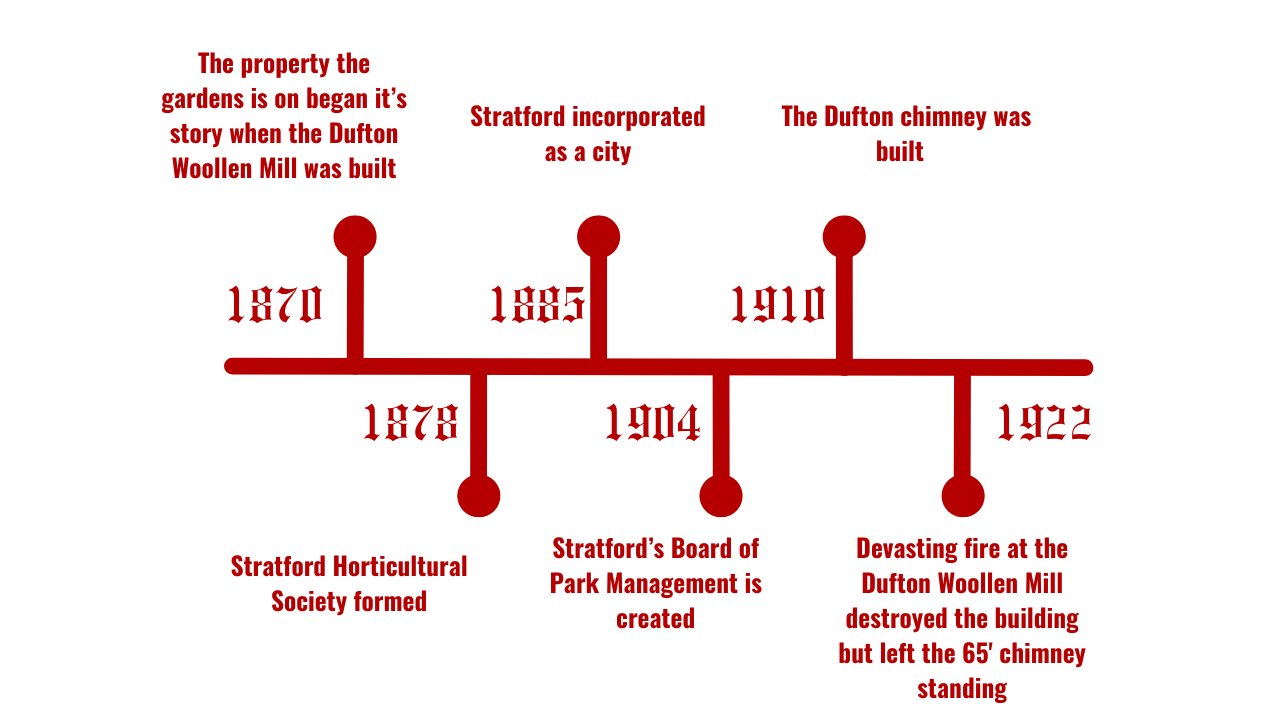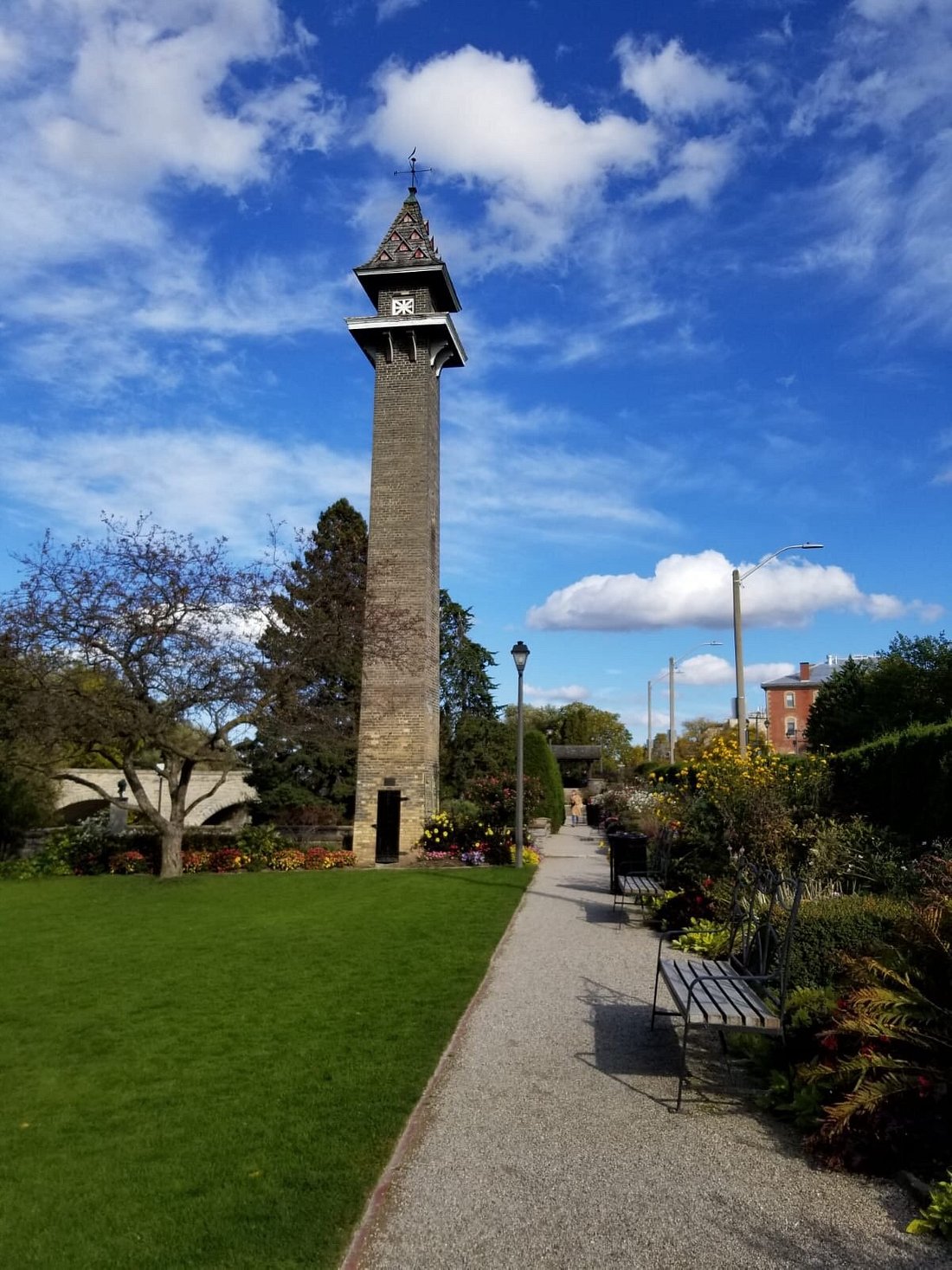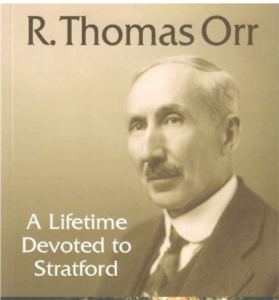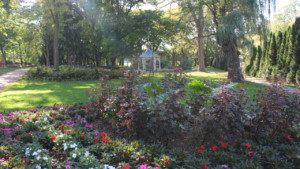Welcome to Stratford's Historic Shakespearean Garden
Whether you’re visiting Stratford or one of our local citizens, the Shakespearean Garden is one of Stratford’s most popular destinations. While it’s always an absolute delight to wander through the scenic grounds, there’s also much to learn about the property’s many features and surprisingly rich history which can greatly enrich your next visit. We invite you to explore the page below to find out more about our incredible garden.
What is a Shakespearean Garden?
A Shakespearean garden, also known as an Elizabethan or Tudor garden, is a style of garden design that draws inspiration from the gardens of the Elizabethan era in England, during the time of William Shakespeare (1564–1616). These gardens were prevalent in the late 16th century and early 17th century and reflected the aesthetics and horticultural preferences of the Renaissance period.
Key features of a Shakespearean garden include:
1. Symmetry and Order: Gardens were often designed with a symmetrical layout, reflecting a sense of order and balance. This symmetry was achieved through the use of geometric patterns and carefully planned arrangements.
2. Herb Gardens: The cultivation of herbs and medicinal plants was a common practice in Shakespearean gardens. These gardens often included a section dedicated to various herbs, which were not only valued for their culinary uses but also for their perceived medicinal properties.
3. Knot Gardens: Intricate knot patterns made with low-growing plants, such as herbs or dwarf hedges, were a distinctive feature. These geometric designs were laid out on the ground and often resembled the patterns of woven knots.
4. Arbors and Pergolas: Wooden structures like arbors and pergolas were frequently incorporated into the garden design. These structures served both decorative and functional purposes, providing shaded walkways and spaces for climbing plants.
5. Use of Topiary: Topiary, the art of shaping and trimming plants into decorative forms, was embraced in Shakespearean gardens. Bushes and shrubs were pruned into geometric shapes or sometimes into representations of animals and symbols.
6. Floral Borders: Gardens featured carefully arranged borders filled with a variety of flowering plants. Roses, marigolds, lilies, and other colorful flowers were commonly planted, contributing to a vibrant and visually appealing landscape.
7. Sundials and Statuary: Decorative elements like sundials and classical statuary were often placed strategically within the garden. These additions added a touch of elegance and served practical purposes, such as timekeeping.
The design principles of a Shakespearean garden aim to create a harmonious and balanced outdoor space that combine both aesthetic beauty and functional utility, reflecting the cultural and artistic sensibilities of the Elizabethan period.

The History


The Dufton Wollen Mill 1894
Here we see the Dufton Wollen Mill 16 years before the addition of the 65′ tower that would take place in 1910. Later on, a fire would destroy the building, creating the space which to this day hosts the spectular Stratford Shakespearean Gardens.

The 65' Tower Remains a Striking Landmark
Added onto the mill in 1910, the 65′ tower survived the devasting fire which destroyed the large Dufton Wollen Mill building in 1922. To this day, visitors can revel in the historic splendor of this incredibily unique tower.
The History Continued…
1917 - R.T. Orr: Local Visionary Searches for Property for Invisioned Shakespearean Garden
As early as 1917. R.T. Orr, a local historian and architect, as well as an avid supporter of the park system, begin contemplating the initial idea for a Shakespearean garden in Stratford. Orr was adamant on finding a site along the developing Avon River which could host the new garden, but could not find an appropriate site.

1922 - The Dufton Wollen Mill Fire
Five years later, while R.T. Orr’s search was still underway for a suitable riverside property for the invisioned Shakespearean gardens, fate intervened with a devastating fire at the Dufton Woollen Mill on Huron Street.
The Dufton family assessed the losses after the fire and decided that rebuilding the mill would be out of the question. Truly, only the 65′ chimney survived the fire.
R.T. Orr heard about the family’s decision not to rebuild, and realized the property the mill was on would be ideal for his invisioned Shakespearean garden, he began lobbying city council friends to consider purchasing the property.
At first, it seemed like an agreement would be difficult to reach between the land owners and the city. The Dufton family was asking what Stratford City Council found to be an exorbitant price. However, aside from the city, no one was coming forward to make any offers on the property and eventually the Dufton family would have to decide to except the city’s offer.
1925 - The City of Stratford Acquires the Dufton Mill Site
R.T. Orr surveyed the newly purchased site and stored away much of the undamaged quarry stone. He sold off much of the salvageable materials found still on the site and returned the proceeds to the city – drastically reducing the city’s cost of the property.
1927 - Orr Designs a Superstructure for Top of Chimney
Being a skilled architech and feeling grateful that the fire hadn’t destroyed the Dufton Chimney, Orr designed a conical roof which contained birdboxes and displayed a prominent weather vane.
Around this time, Orr traveled to Britain to find inspirtation for his new Shakespearean garden. It was there he met the Shakespeare Birthplace Trust Chairman, Sir Archibald Flower.
1929 - The Great Depression Sets Back The Project
Although Mr. Orr’s vision seemed well underway, no one expected the financial crash of 1929 nor the depression that would enivatably follow.
New building projects such as this were all shut down due to financial constraints. It would be 14 long years before R.T. Orr’s garden project would recommence and be finally realized.
1934/1935 - Financial Hardships Ease, City Approves Construction
Sensing an improved financial situation, R.T. Orr received city approval to restart the garden project. During this time, the city hired one of Canada’s most celebrated landscape architechs Dunnington, Grubb and Stenson to produce working blueprints for the garden site.
1936 - Governor General Officially Opens the Garden
The City of Stratford invited Governor General Lord Tweedsmuir and his wife to open the garden.
1949 - William Shakespeare Bust
the Sons of England commissioned a handsom bust of William Shakespeare and it was installed in the rose garden with the Canadian sculptor Cleeve Horne in attendance.

1960s-70s - Property Expanded and Gazebo Donated
Over the 1960s and 70s, the garden continued to see improvements and thrived with the added tourism Stratford was experiencing after the opening of the Stratford Shakespeare Festival in 1953. During this period, the city acquired an additional piece of property at the west-end of the garden known as the woodland. This shady oasis would soon after benefit from the donation of a gazebo that remains to be enjoyed to this day.

2018 - The Friends of Stratford's Shakespearean Gardens Forms
A group of garden enthusiasts formed an organization dedicated to Stratford’s Shakespearean Garden. The Friends of Stratford’s Shakespearean Garden meet monthly to discuss and implement various intitatives which benefit the garden and its visitors, while also bringing awareness to its historic significance. By supporting the Board of Park Management, The Friends have a direct impact on the ongoing effort to maintain this historic garden.
The Long Bed
Nestled gracefully along the garden’s expanse, the Long Bed unfolds like a vibrant tapestry, stretching an impressive 265 feet in length beginning at the entrance to the garden off of Huron Street. This floral haven boasts an array of colors and fragrances, providing a picturesque panorama for all who wander its length. Signage strategically placed throughout the bed serves as a knowledgeable guide, unveiling the secrets of each bloom.
As you embark on a leisurely stroll beside the Long Bed, the kaleidoscope of hues captures your gaze. Delicate petals sway gently in the breeze, creating a mesmerizing dance of nature’s artistry. The meticulously curated collection showcases an assortment of flora, from classic elegance to the whimsical allure of wildflowers.
The air carries a sweet symphony, a melodic collaboration of buzzing bees and the occasional flutter of butterflies drawn to the nectar-rich blossoms. The Long Bed, a living canvas, ensures an ever-changing spectacle for those who frequently visit this incredible spectacle.
Bordering the majority of the property, the Long Bed invites contemplation and discovery. Each section introduces a new palette of colors and textures, creating an immersive experience for enthusiasts and casual admirers alike. Visitors are invited to pause at the strategically placed benches, allowing for moments of quiet reflection amidst the blooming spectacle.
Beyond the sheer visual delight, the Long Bed is an educational journey. Thoughtfully designed signage provides botanical insights, offering a deeper understanding of the diverse plant life adorning the bed. Whether you’re a seasoned horticulturist or a curious novice, the Long Bed beckons you to explore the rich tapestry of nature it unfurls, a celebration of the beauty that flourishes under the open sky.
The Herb Garden
Nestled gracefully along the garden’s expanse, the Long Bed unfolds like a vibrant tapestry, stretching an impressive 265 feet in length beginning at the entrance to the garden off of Huron Street. This floral haven boasts an array of colors and fragrances, providing a picturesque panorama for all who wander its length. Signage strategically placed throughout the bed serves as a knowledgeable guide, unveiling the secrets of each bloom.
As you embark on a leisurely stroll beside the Long Bed, the kaleidoscope of hues captures your gaze. Delicate petals sway gently in the breeze, creating a mesmerizing dance of nature’s artistry. The meticulously curated collection showcases an assortment of flora, from classic elegance to the whimsical allure of wildflowers.
The air carries a sweet symphony, a melodic collaboration of buzzing bees and the occasional flutter of butterflies drawn to the nectar-rich blossoms. The Long Bed, a living canvas, ensures an ever-changing spectacle for those who frequently visit this incredible spectacle.
Bordering the majority of the property, the Long Bed invites contemplation and discovery. Each section introduces a new palette of colors and textures, creating an immersive experience for enthusiasts and casual admirers alike. Visitors are invited to pause at the strategically placed benches, allowing for moments of quiet reflection amidst the blooming spectacle.
Beyond the sheer visual delight, the Long Bed is an educational journey. Thoughtfully designed signage provides botanical insights, offering a deeper understanding of the diverse plant life adorning the bed. Whether you’re a seasoned horticulturist or a curious novice, the Long Bed beckons you to explore the rich tapestry of nature it unfurls, a celebration of the beauty that flourishes under the open sky.
The Island
The island in Stratford’s Shakespearean Garden is a whimsical wonder to behold. It offers a secluded, shady place for a picnic, surrounded by the Avon River. Visitors looking for a suitable place to sit and reflect over the water will find more than one amazing spot here on the island. There is a bench at either end of the island, both offering one-of-a-kind views of Stratford and the Avon River.
The island has remained pretty well untouched over the decades aside from an enhancement project in the 2000’s which added a new perimeter of stone and some additional earth, in order to curb the natural erosion process. The older, dated stone from the unenhanced island can still be seen – allowing one to imagine how the island has changed slightly since the project.
Knot Garden & Sundial
The Knot Garden is reminiscent of a Shakespearean garden, adding a touch of timeless charm to the surroundings. This unique garden feature is like a living puzzle, carefully arranged with neatly trimmed hedges and plants. Picture a beautiful outdoor carpet made of nature, inspired by the classic designs often found in the Bard’s era. At the center of the Knot Garden is a sundial which was donated to the garden’s visionary R.T. Orr, by Sir Archibald Flower, Chairman of the Shakespeare Birthplace Trust in 1927. The sundial’s gnomon (a vertical rod or blade that casts a shadow onto the dial plate) is missing, and The Friends of Stratford’s Shakespearean Garden are currently working to have it replaced as soon as possible.
The Rose Garden
Nestled beside the majestic 65-foot-tall Dufton Tower, the rose garden unfolds as a fragrant oasis, enclosed by low stone walls that lend a touch of rustic elegance. A symphony of colors and scents greets visitors as they enter this enchanting space, where meticulously tended rose bushes create a captivating display.
The low stone walls, weathered with time, encircle the rose garden like ancient sentinels, providing both a sense of enclosure and an open invitation to explore the floral wonders within. Beyond the stone boundaries, the Dufton Tower stands tall and proud, its architectural splendor adding a historical backdrop to the delicate beauty of the roses.
At the heart of this aromatic sanctuary, the bust of William Shakespeare stands as a silent tribute to the literary genius. Positioned strategically amidst the blossoms, the bard’s likeness adds a touch of cultural significance to the garden, inviting quiet contemplation amidst the natural beauty that surrounds him.
In 2022, The Friends contributed the funds for fifty David Austen roses which completely renovated the rose garden.
The Woodland
Nestled discreetly at the rear of the garden property, the Woodland exudes tranquility, adorned with mature trees that offer ample shade, providing a welcome retreat from the scorching heat of summer days. A winding path weaves through the Woodland, inviting contemplative strolls amidst the rustling leaves and dappled sunlight, along side the Avon River. The air is filled with the soothing melodies of birdsong, creating a serene atmosphere that beckons both relaxation and reflection. As you venture further into the garden, well-landscaped and vibrant flower beds come into view, encircling an elegant gazebo, which has served visitors as a wonderful place to relax since it was donated in the 1960s.
